Outdoor art at Art Rotterdam
Art is often displayed and experienced in a similar context: the distinctive white walls of a gallery or museum. The iconic Van Nelle Factory, part of the UNESCO World Heritage List, already stands out from this traditional white cube concept due to its unique architectural character. Moreover, the fair offers an additional way to experience art: outdoors. Around this historic building, more than 20 (often large-scale) artworks are exhibited during Art Rotterdam. Free from the confines of walls, these works become part of their environment and gain new meanings in the process.
Atelier Van Lieshout (presented by Galerie Ron Mandos)
Atelier Van Lieshout is known for its multidisciplinary practice that straddles the boundaries of art, design, and architecture. Joep van Lieshout often uses industrial materials to explore socio-critical and provocative themes. At Art Rotterdam, he presents the work “Vulture” (2022). Vultures are as imposing as they are repulsive. Death is near when this scavenger arrives. However, vultures are also resourceful, persistent and an indispensable link in many ecosystems. According to Van Lieshout, artists are comparable to vultures. They devour everything that might serve as inspiration, old and new, and are viewed with suspicion. Van Lieshout would have preferred to see collectors viewed as vultures: as they hungrily circle vulnerable art. Van Lieshout's works have been featured at the biennials of Gwangju, Venice, and São Paulo and are part of the collections of Fondation Prada, FNAC, Museum Boijmans Van Beuningen and the Stedelijk Museum.
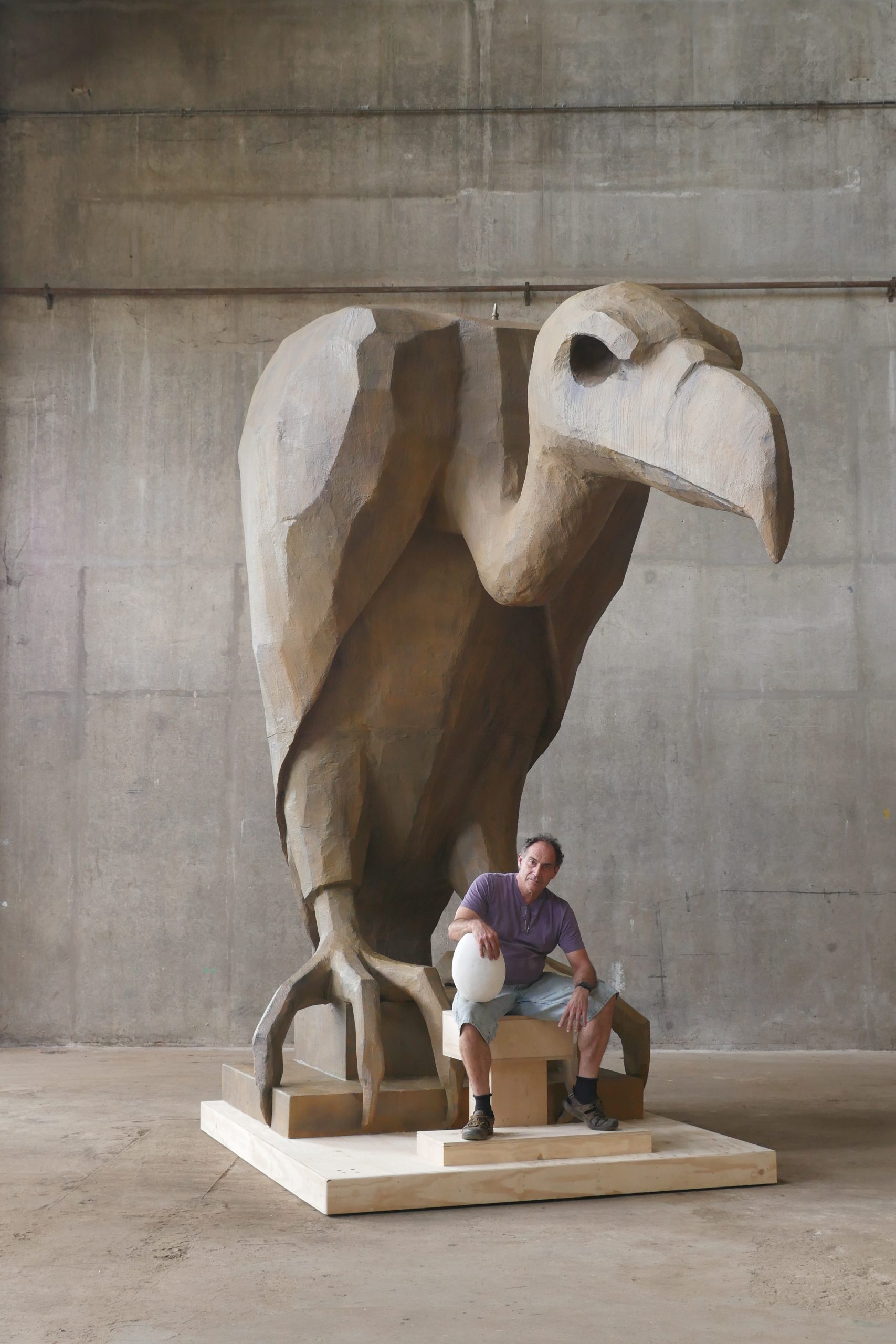
Baoyang Zhao (presented by Josilda da Conceição Gallery)In Baoyang Zhao's work, intangible phenomena often take on a tangible charge. A scent, or a memory. The artist graduated from the HKU last summer and will present the work “The Trace of a Ghost Walking along the River” (2023-2024). How can you not wet your shoes when you walk along the river? This project talks about the bodily pleasure with the absence of the body. The artist explore the topic under the context of their experience as non-binary person. The liminality of their body aligns with the key experience with pleasure which dwells only on the border of land and water, indulgence and restriction. We hear the whisper of the pleasure under the water meanwhile we know the land is where we can stand on. We wet our shoes. We linger and we walk along the river. But what will be wet when a ghost floating along the river? What will be left in he bodily pleasure when the body is missing?
Jonas Dehnen (presented by Pizza Gallery)
With the work “Pterion shelter, oder die dünnste Stelle des Schädels” (2023), Jonas Dehnen plays with the genre of the sculptural garden folly. A folly, in architecture, is a primarily decorative garden building, which through its appearance suggests a fictional history (for example a fake ruined castle or grotto). Dehnen's work can be read as a sculptural proposal for a dilettante park folly in the shape of a tin-foil hat, a homemade protective device, and a symbol of paranoia and conspiratorial thinking. It expands on the visual language of the artist’s paintings and drawings, which for several years have integrated themes such as the painterly landscape, maps of historical garden designs, automata, and hermitages. These undergo a subjective examination led by the (im-)possibilities and the ‘cultural memory’ of the material. The sculpture is partly made of the plates used to print the book.
Joeri Woudstra (presented by Nest)
As the February sun traces its short arch over Rotterdam, sounds of Joeri Woudstra’s work will echo over the terrain of the Van Nelle Factory. Woudstra, a multidisciplinary visual artist and composer, presents work from his series “Radiate” during Art Rotterdam. For this giant cross made of speakers, Woudstra mixed echoes, samples, and loops from pop music with iPhone recordings and live performances recorded during sunsets.
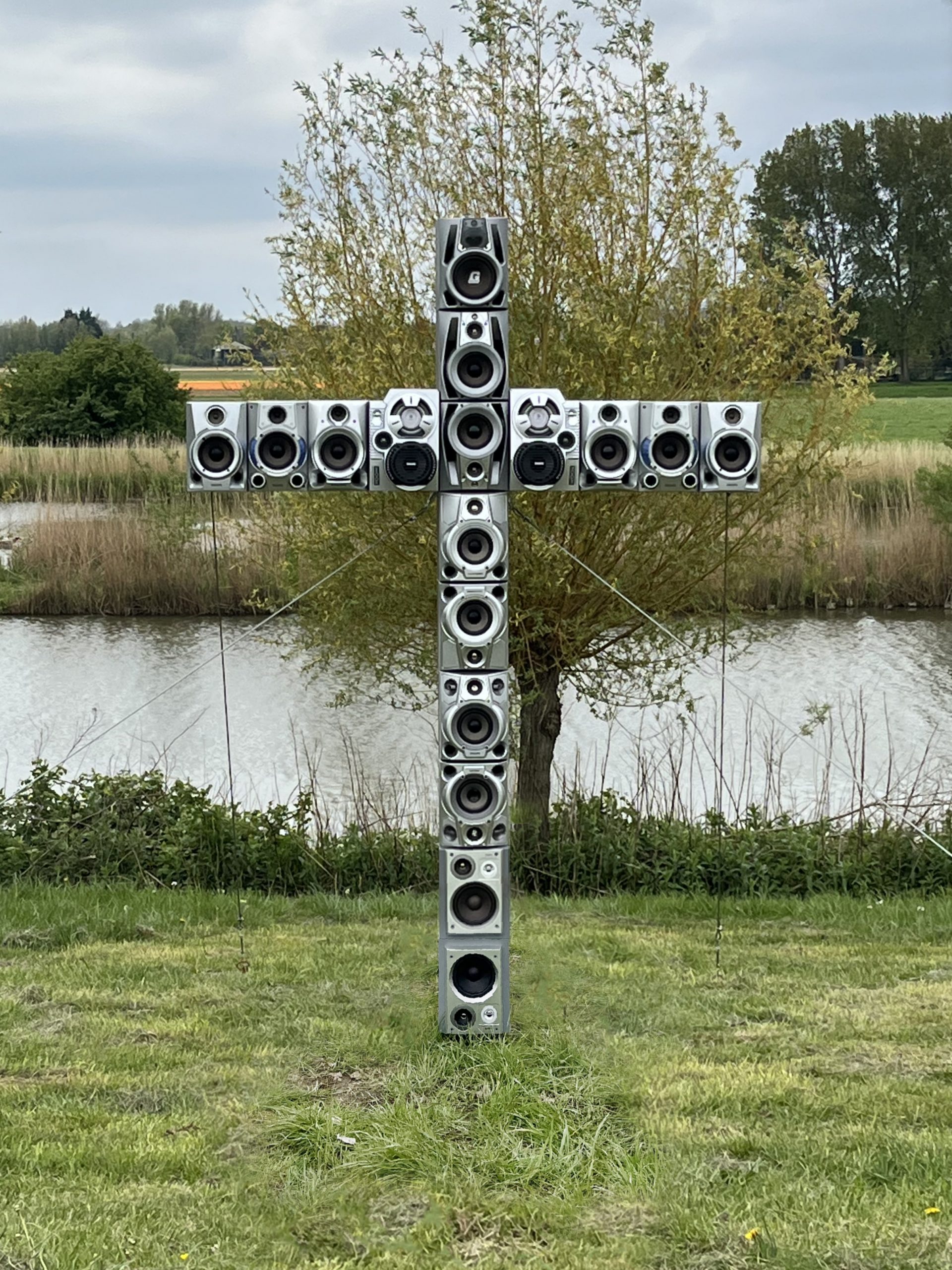
Karin Kytökangas (part of the Prospects exhibition organised by the Mondriaan Fund)
“I wish the world were softer,” Karin Kytökangas (1991) confesses. With paintings and sculptures executed in a dreamlike visual language, the artist challenges painful power structures. She is especially interested in the tension between power on the one hand and vulnerability on the other. In order to depict this tension she uses the contrasts between soft and hard. The vulnerable, soft medium of painting, for instance, can simultaneously be hard when using a powerful visual language or making a strong substantive statement. The sculpture “The Long Haul” (2023), standing outside the Van Nelle Factory, is literally a soft object that is now hard: a fixated white flag eternally billowing in the wind. For the artist, this work is about a desire for peace. By creating contrasts between shape and content, Kytökangas encourages us to surrender to reality and argues in favour of innovation.
Dré Wapenaar (presented by NL=US Gallery)
The oeuvre of the Dutch sculptor Dré Wapenaar is closely linked to architecture. Monumental tent constructions are a recurring form in his practice, often as a reaction to the urban space. His ecological works often have a very specific purpose and offer space for the human dimension. For example, he designed a tent for sellers of street newspapers and tents that involve death and birth. How do people use the public space and does that space reflect those same people? Wapenaar hopes to start a dialogue between citizens and their city. During Art Rotterdam, he presents “TENTVILLAGE REVISITED” (2007), a microcosm of society. Wapenaar says: “You can see this work as my proposal for urbanization.”
Oscar Peters (presented by C.o.C.A.)
Oscar Peters predominantly creates large-scale kinetic sculptures. In his latest works, he explores encompassing themes such as loss, grief and fury. At Art Rotterdam, he exhibits “The Gift of Fury” (2024), in which he investigates collective grief, joy and the need for hope in the face of contemporary alienation. This is achieved by integrating elements from other cultures and rituals, as well as cinematic traditions of world building. Like walking into an alternate universe, the installation evokes strong feelings, like those inspired by the romantic, almost sentimental depictions in pre-raphaelite paintings of death, loss, grief, and mourning. Fury, born from these emotions, is not necessarily blind anger but rather a directed or guided rage, with a potent goal, either to destroy or create. Upon entering the work, you are no longer just an observer, but a participant in the creation of the ritual; stepping into a shared place of mourning, a contributor to collective healing. The Collectors of Contemporary Art (C.o.C.A.) foundation consists of a group of eight collectors of contemporary art, united with the goal of supporting the work of young, promising artists in the Netherlands by providing an annual grant.

Marcel Mrejen (part of the Prospects exhibition organised by the Mondriaan Fund)
Greenhouse cultivation enables new landscapes to exist within established ones, as a greenhouse set up in the polder, for instance, can accommodate a different climate for growing crops. Marcel Mrejen (1994) collected greenhouse sounds, such as the buzzing and droning of ventilators, pumps, and neon lights. He then fed hours of these audio recordings to an artificial intelligence that transformed them into a soundscape. Placed outside the Van Nelle Factory, the installation “Cottagecore (Paradise Haunts Growth)” (2022) is playing this soundscape with the help of nine speakers. The artist is no longer in control of what the installation allows the public to hear, while its duration is undetermined as well. Apart from being a spatial entity, the sculpture thus also extends over a period of time. Occasionally, the installation produces the sound of a voice. According to Mrejen this is the algorithm’s consciousness contemplating the costs of growth: How can we use technology to restore non-exploitative relationships with the planet?
Geraldo Dos Santos (presented by Josilda da Conceição Gallery)
Geraldo Dos Santos, known for his affinity for narrative complexities, introduces "La Santeria de Mama" (2023-2024) as a profound endeavor in cultural decolonization. By centering on the symbolic significance of candles, meticulously deconstructs hierarchical systems associated with the persuasion of these ritual objects. This prompts thought-provoking inquiries about the multi-emigrated identity. "La Santeria de Mama" manifests as an installation of stories, with each candle representing a chapter in the ongoing narrative of cultural resilience. Specifically chosen for their tenacious spirit, the candles transform into a powerful metaphor symbolizing the enduring strength of cultural identities from Latin America. This hegemonic phenomenon transcends conventional art boundaries, acting as a catalyst for a parafiction. The vibrant colours of the sculptures disrupt monochromatic narratives, creating space for nuanced perspectives. Uncomfortable truths embedded in migration narratives are exposed as preconceived notions are dismantled, prompting a collective reexamination of societal structures that perpetuate hierarchies based on origin and heritage.
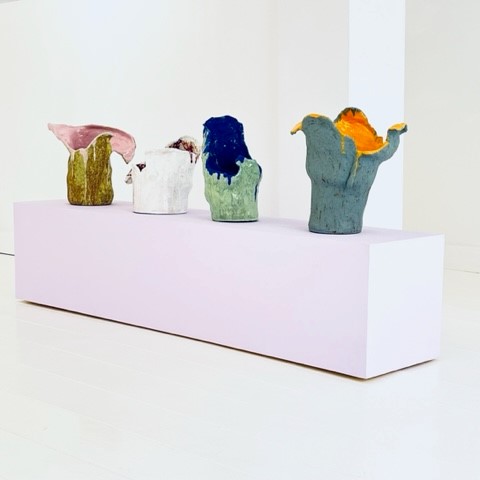
Adriaan Rees (presented by Livingstone Gallery)
High in the air, at over 4 meters, stands a striking lilac sculpture on a metal pole. The polyester figure is a woman bent over with a bucket in her hands. Her head, covered with long hair, is largely hidden in the bucket. The title of the work, “Screaming in a Bucket” (2023/2024), is evocative and originates from a dream. At their booth on the fair floor, Livingstone Gallery will present a special edition of this work in porcelain with silver. Rees, known for his versatility in materials, splits his time between Amsterdam and his own studio in Jingdezhen, China. He creates sculptures and installations and works on large-scale projects, performances, and sculptures for public spaces.
John M. Robinson (presented by A Modest Show)
British artist John M. Robinson is known for his performance paintings. During tarot readings and other occult or spiritual events, the artist embodies new personas, which become the documented paintings. At Art Rotterdam, Robinson will perform in a modest garden shed outside the Van Nelle Factory, adorned with images and equipped with spy holes. At scheduled times, he will perform a number of durational works there.
Marieke Bolhuis (presented by NQ Gallery)
Marieke Bolhuis exhibits an installation of three sculptures: “Starting point, YOU ARE HERE” (2023). The artist works intuitively, in continuation of her interest in emotions, psychic states, awareness. In a constant dialogue with shape and material, she thinks through doing. These three sculptures can be seen as individual sculptures, but together form a powerful installation. Bolhuis: ”A life with and in nature, sprouting from the dark earth. The miracle that the most beautiful shapes and colors come to life from that nutrient-rich organic earth's crust. Life forms, organisms, plants and animals, working together to create an incredibly diverse and rich landscape." The work is a continuation of “If we would all be plant”, which was on display at the fair last year.
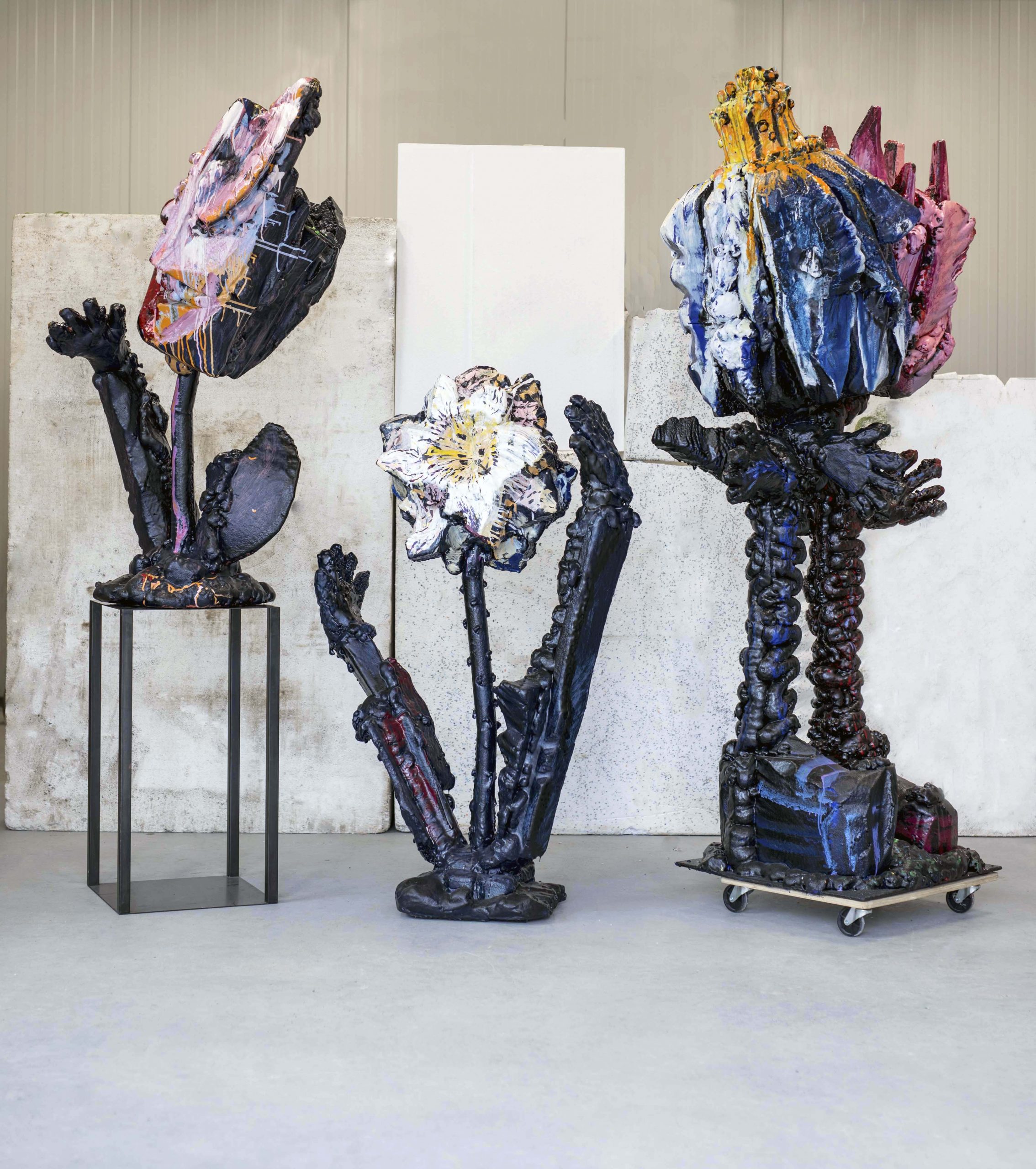
Cecilia Bjartmar Hylta (part of the Prospects exhibition organised by the Mondriaan Fund, courtesy diez gallery)
Cecilia Bjartmar Hylta (1992) often takes themes like infrastructure and urban planning as points of departure for new work. She is interested in how we move though the outside space, in the demands placed on us by structures, and in the reactions these evoke. In her work she tries to mimic public situations in order to visualize their underlying, often invisible, forms and ideas. For the sculpture “Van Nellefabriek” (2023), the artist collected dust from the Distribution Centre which she compressed to form a miniature version of the building. With this sculpture Bjartmar Hylta is thus inverting content and form.
Art van Triest (presented by MPV Gallery)
Control is a recurring theme in the work of Art van Triest: “Central to my work is the human tendency to fight our fundamental fear with a system, to get a grip on the world around us and satisfy our need for control. My work is a visual investigation, in which I question how this system relates to the physical reality of the world around us. With my work I want to offer a visual counterbalance to the simplification and standardization of our environment. I would like to strive for a more realistic positioning of man, in which we can relate to reality in a more complete way”. “Lines” (2023) is a sculptural installation, it explores a balance between systems. It attempts to portray contrasts between possible ways of relating to our environment. Focusing on strength and calculating reliability or arising from a development process it portrays various ways of working and thinking.
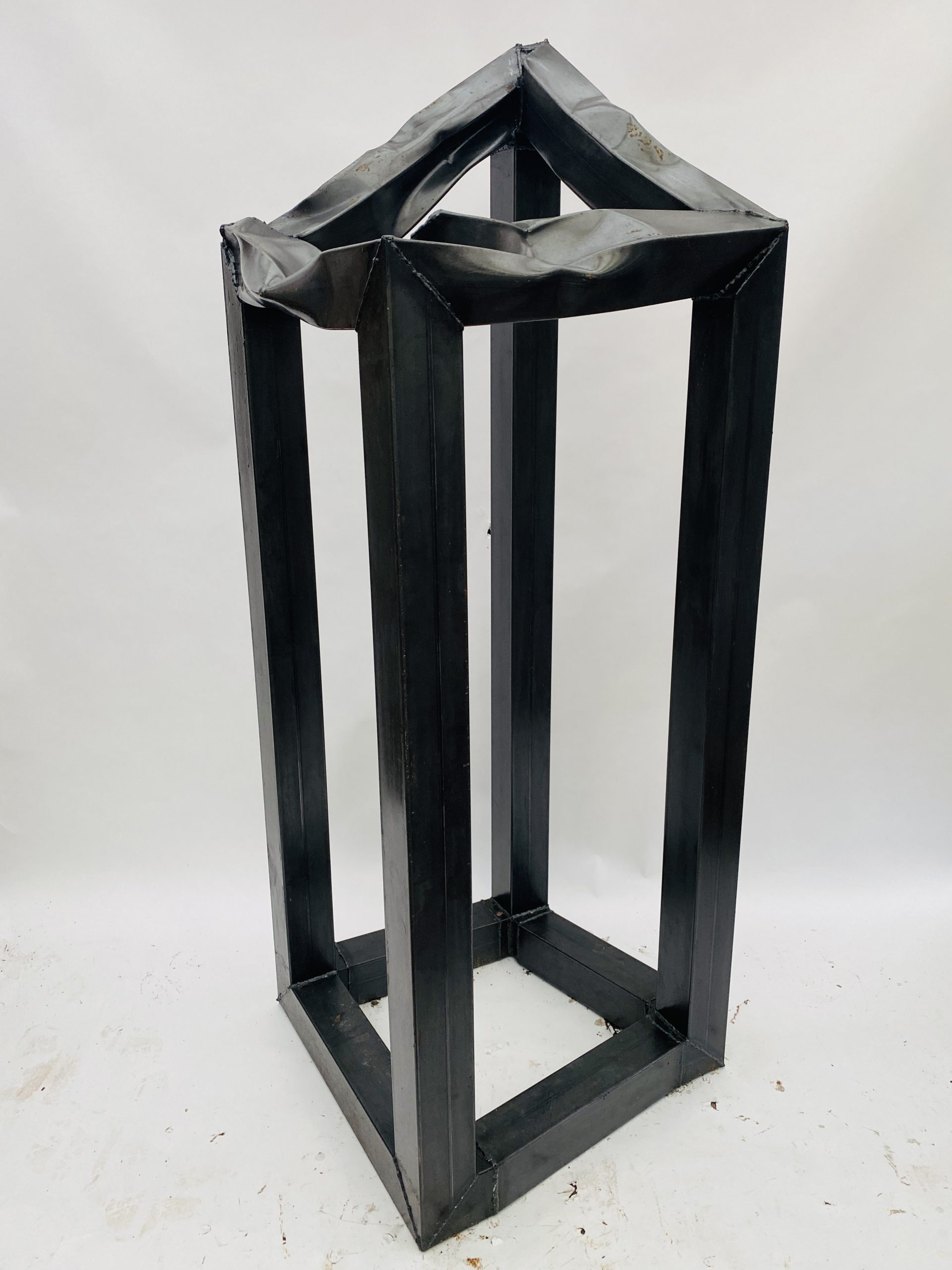
André Kruysen (presented by NL=US gallery)
André Kruysen presents 'Dependent perspective (whale’s eye)' (2023). Kruysen’s work relates to daylight and the structure of the architecture around him. He makes interventions in spaces that influence these aspects. These interventions can result in both freestanding and space-merging sculptures. His more complex and chaotic language of form in recent years stems from the increasingly complex (visual) culture in which we live. The search for a personal balance in it finds its form in his work. In the midst of his disruptive spatial interventions, Kruysen seek silence: the stillness that occurs due to the sacred effect of daylight. This contradiction is the basis of his sculptures.
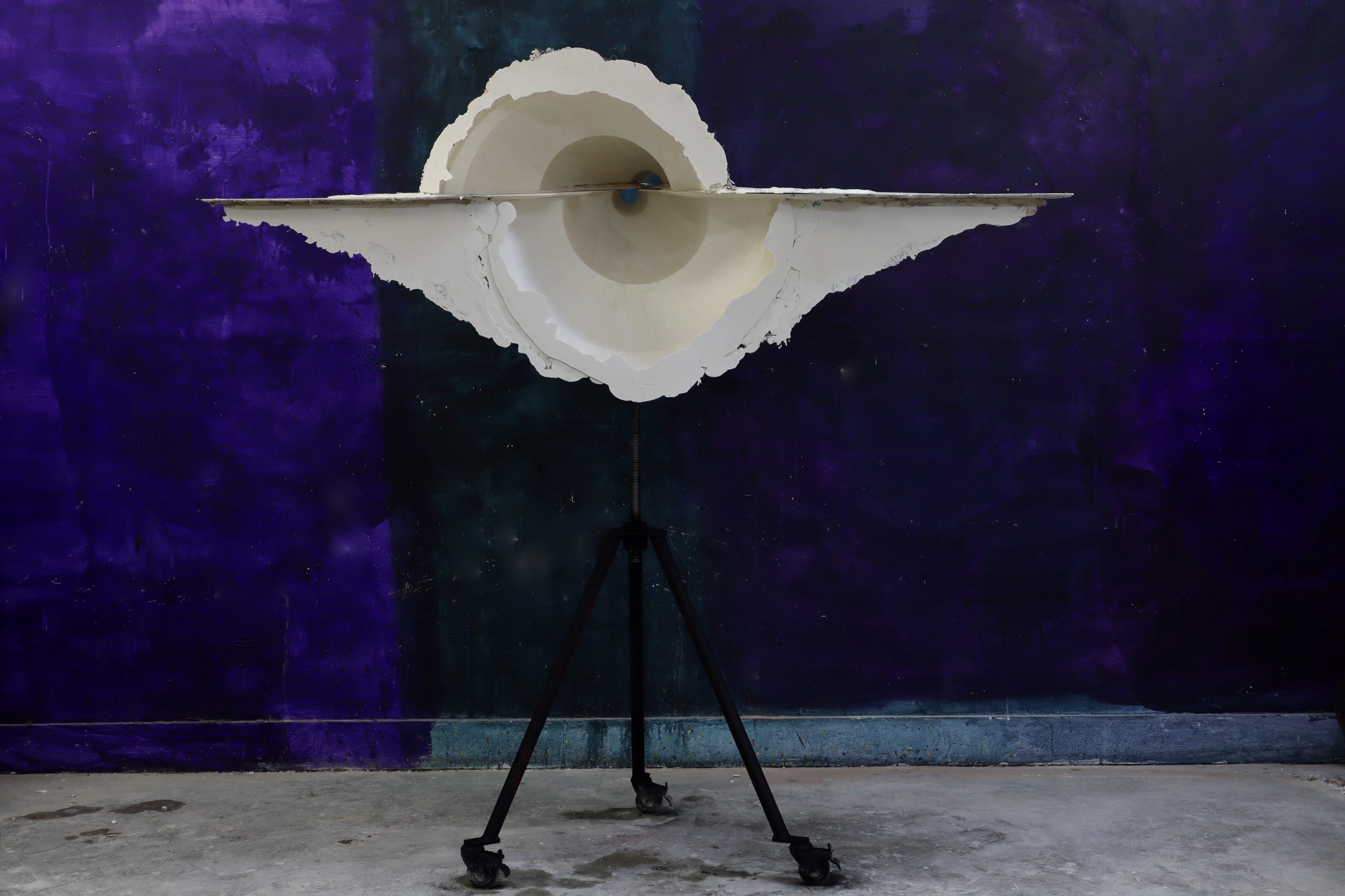
Olaf Mooij
Rotterdam-based artist Olaf Mooij has gained particular renown for his car sculptures in public spaces. At Art Rotterdam, he presents “The Church of our Unbelieving Faith” in a mysterious, chapel-like structure. In this beautiful chapel you fall from one surprise to the next. Having entered you have to let your eyes do the work. "What should I believe?" And "What do I want to believe?" Are questions that stay with you after seeing all those special objects. Do you believe in the sacredness of the technology? Or do you believe that the holy cow is alive and created from an auto-spermatozoid? Is our car such a great invention? Isn't it better to continue electrically? And to whom do we prefer to leave our fate: the human driver or the self-thinking machine? These kinds of aspects are highlighted in this ‘church’.
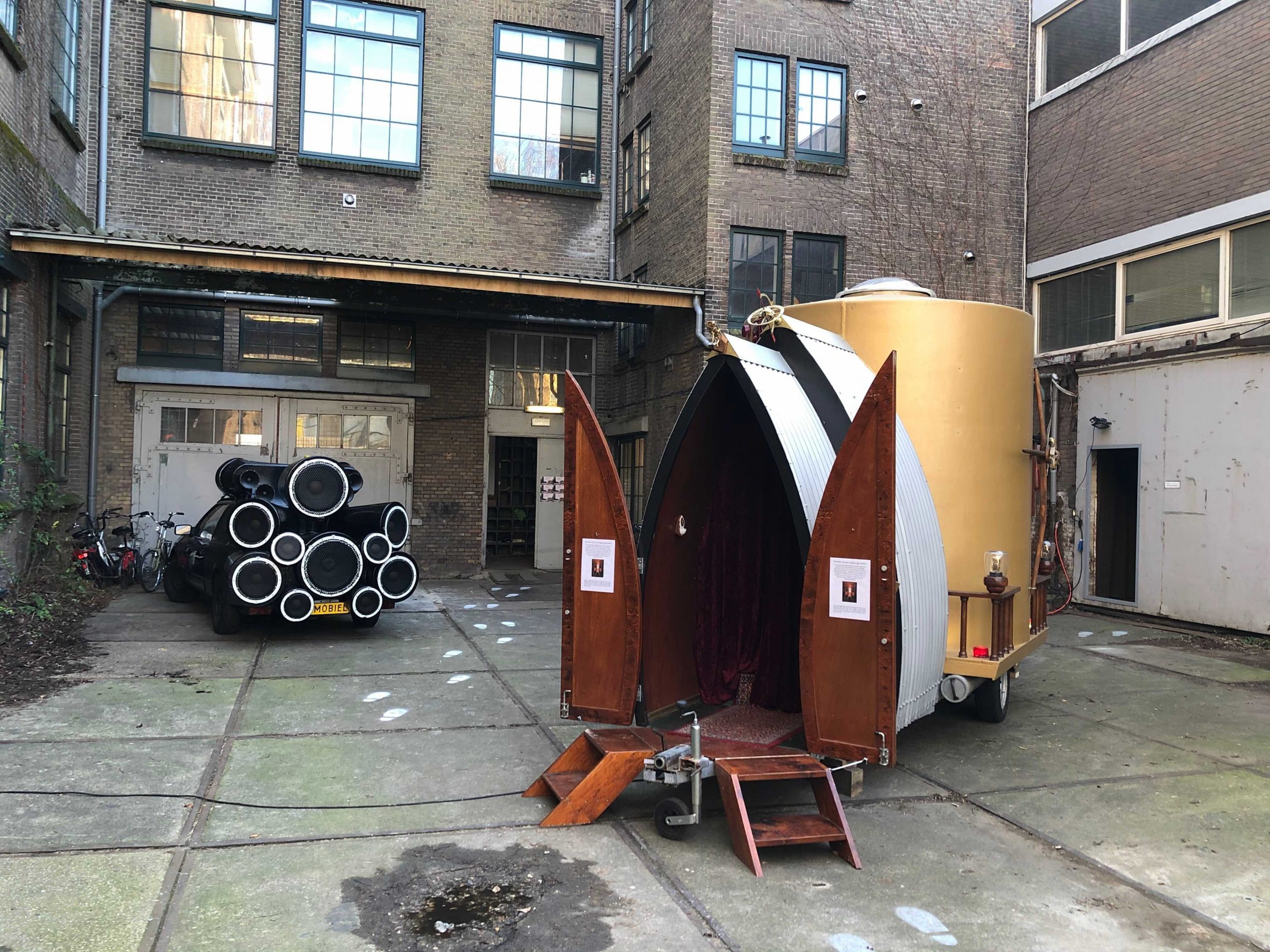
Thordur Hans (presented by Rademakers Gallery)
It is often the familiar and mundane that takes centre stage in the work of Icelandic artist Thordur Hans. His practice revolves around being perceptive of interesting gestures that one might come across in their everyday life. These gestures then develop into artworks in the form of recognisable, slightly modified objects or activities that brings a new perspective to their existence. “Window I” (2021) is a monument to everyday forgetfulness and casual apathy.
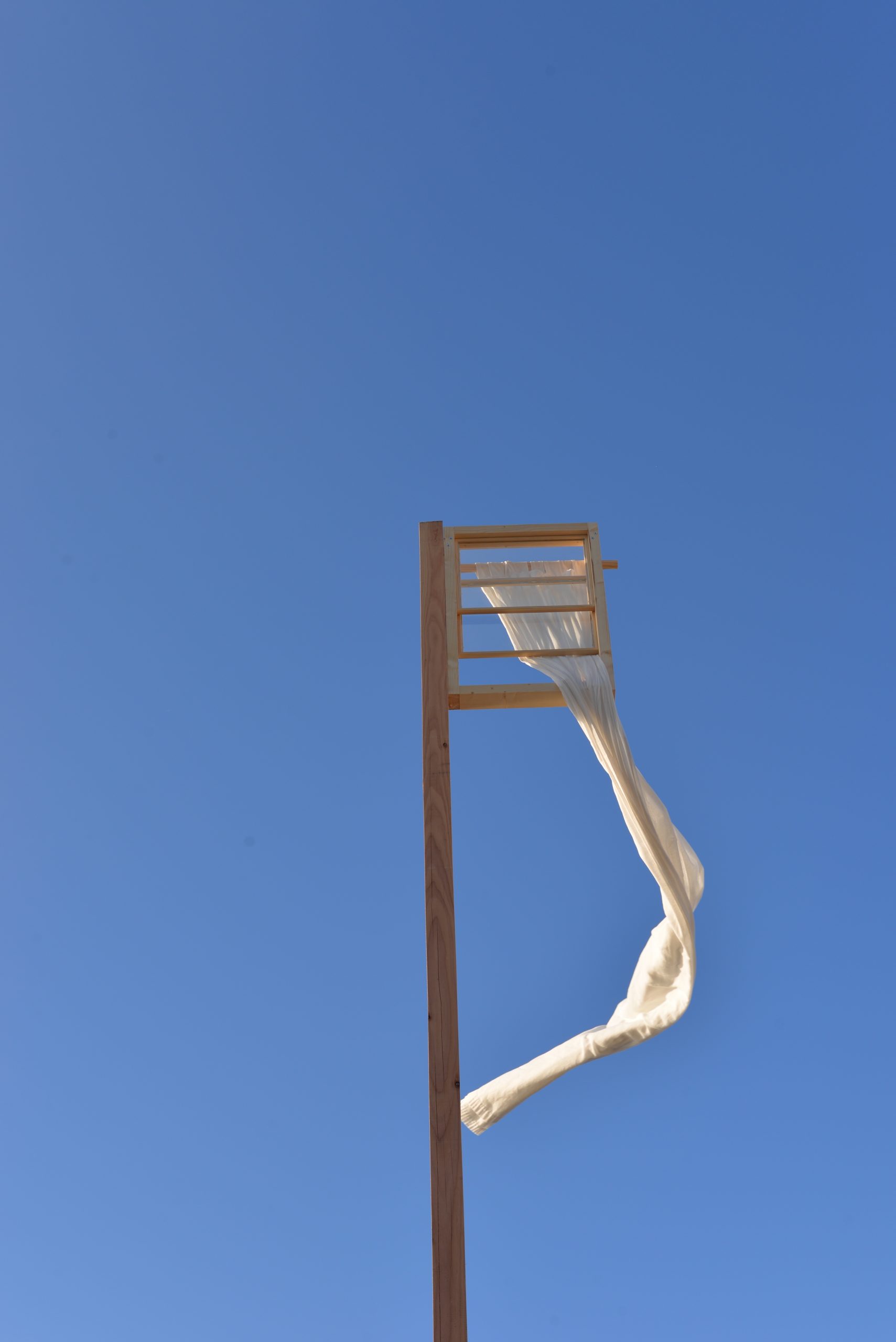
Ruud Kuijer (presented by Slewe Gallery)
Ruud Kuijer is a Dutch sculptor known for his series of large abstract concrete constructions along the quay of the Amsterdam-Rhine Canal near Utrecht, the so-called “Waterworks”. Over the years, Ruud Kuijer has made several large sculptures with flat plates of concrete or iron that hang, lean, lie or stand upright. In “Large Standing Plate” from 2022, a box section and a pipe protrude through a monumental iron plate and keep it visually balanced. The flat surface of a plate is made part of a three-dimensional whole. The front and back of the plate get their own identity. You can walk around it to experience its sculptural character.
Willem Besselink (presented by OMI Rotterdam and NL=US gallery)
The built environment of the city, and the Van Nelle building in particular, consists of an almost infinite number of structures and systems. Willem Besselink is fascinated by the interference patterns that arise in the process, which he visualises in his work. Interference patterns occur when two or more waves, such as light, sound, or water waves, meet and combine. The sculpture “See Through” (2023) is one of the many possible visualisations of the many structures and at the same time contributes to the further accumulation, and its interference patterns.
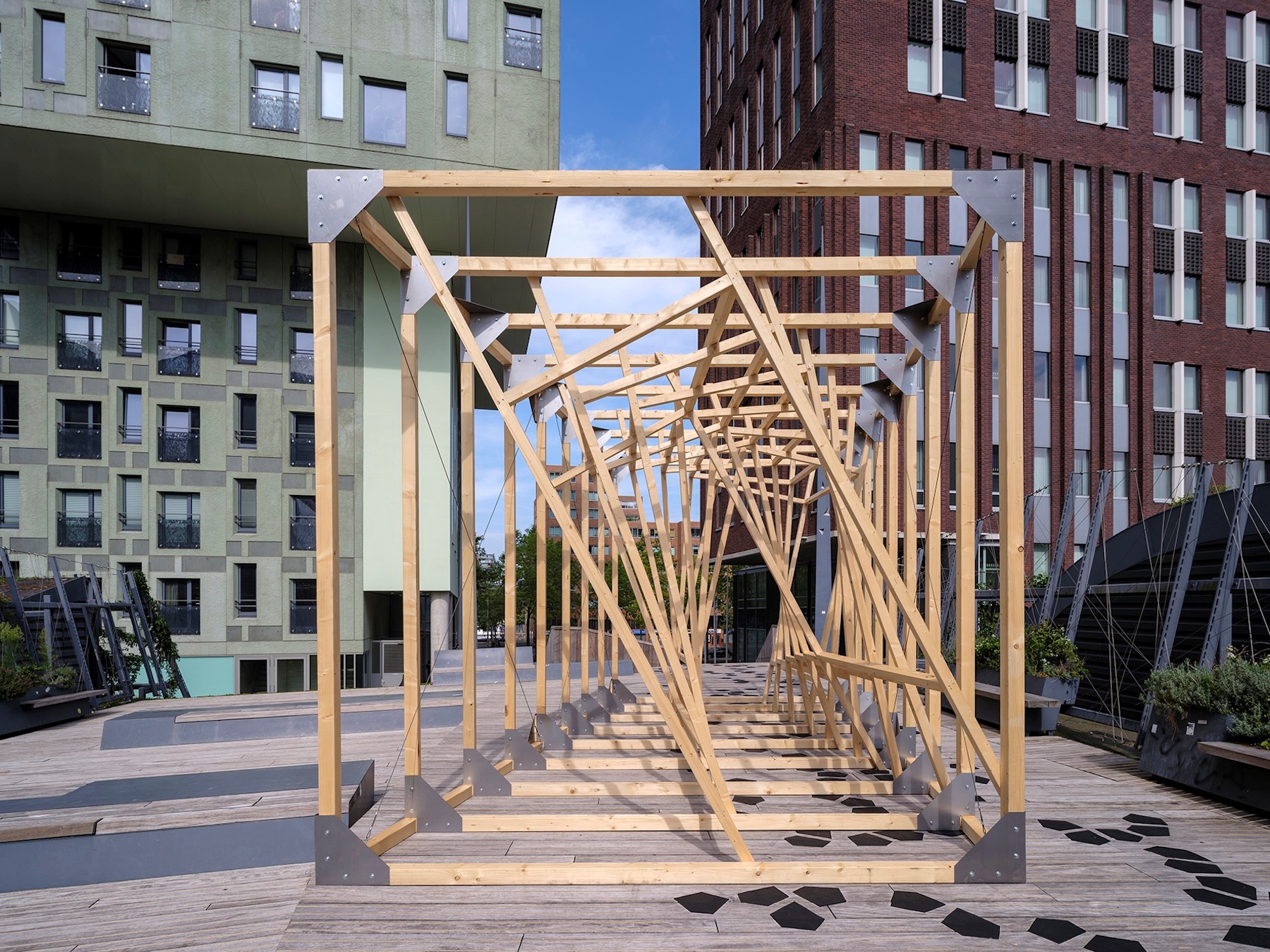
Martinus Papilaja (part of the Prospects exhibition organised by the Mondriaan Fund)
For graffiti artists it is crucial to use a recognizable tag that cannot be traced back to them. This is important because the application of graffiti is forbidden in most places. Martinus Papilaja (1988) considers it a sign of recognition for the specific craft of graffiti that his work is now presented to the public explicitly under his own name. Papilaja studied what the graffiti artist's need or urge to write is, and how this affects their personal handwriting. He thinks of graffiti as a craft that can be perfected through practice and studying the work of others. For his work at Prospects, Papilaja consciously chose to experiment with form. Rather than spray painting a flat surface, he presents three sculptures outside the Van Nelle Factory that establish his tag spatially.
Sanne van Balen (part of the Prospects exhibition organised by the Mondriaan Fund)
Can language present itself in a different guise? This question is a common thread in the work of Sanne van Balen (1994). After graduating in Dutch language and literature, she went on to study Image & Language at the Gerrit Rietveld Academie. Her artworks focus on the visual experience of language, while her writings give images a voice. For her work at Prospects, Van Balen is zooming in on the tongue. On the one hand, the tongue is a muscle that shapes and literally creates language. On the other, ‘tongue’ also refers to the language we speak, the language of a people. This duality is a recurring feature in her work. Lying in the grass outside of the Van Nelle Factory is the work “Stem” (2024), a red, meandering sculpture somewhat resembling a physical tongue. To Van Balen, the landscape is a linguistic site that both contains and conveys the environment’s meanings.
Erik Buijs (presented by Rutger Brandt Gallery)
Erik Buijs sculpts animated figures from clay or wax, deliberately leaving traces of the sculpting process. His artworks serve as a thought-provoking commentary, stirring curiosity and inviting contemplation. Through the intriguing blend of his figures whimsical and childlike appearance combined with somber undertones, Buijs sculptures embody a peculiar yet powerful presence. These figures, seemingly playful yet oddly peculiar, offer a unique perspective on the human condition. Within their seemingly simple forms lie layers of depth, revealing both sensitivity and idiosyncrasy. Buijs intertwines the weighty aspects of human emotion with the innocent essence of childhood, creating sculptures that emotionally resonate with viewers.
Compiled by Flor Linckens


